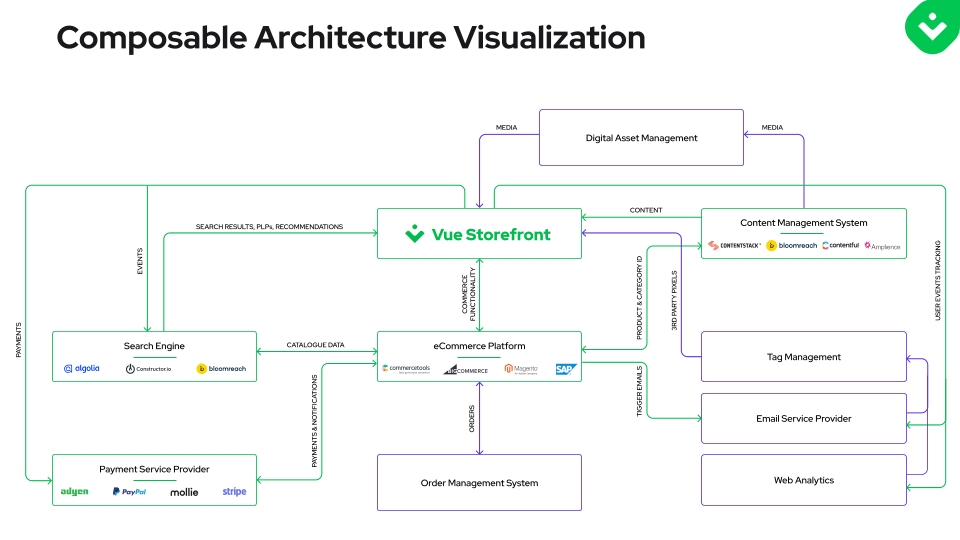Headless commerce is a revolutionary concept that has completely changed the way businesses approach eCommerce. It is a type of eCommerce architecture that decouples frontend and backend of the website, allowing businesses to quickly and easily scale their eCommerce platform to meet customer demands, improve web performance, customer experience and of course sales.
This article highlights key players in the headless commerce space, gives an overview of their offerings, and provides insights into their business models.
A brief intro to headless commerce
Headless commerce is a software architecture that separates the frontend and backend layers of an eCommerce application. This architecture offers brands to become more agile and flexible to test and experiment, and the opportunity to scale their businesses in a way that enriches their customer experience.
Because headless software platforms communicate via API, you can build your software stack anyway you want. This type of headless commerce architecture uncovers almost limitless possibilities in terms of customizations. Thanks to the decoupled backend and frontend layers, developers can easily add, test and remove different features and third-party integrations without interfering with the whole stack. This implies that they can develop, implement and scale multiple services at different speeds without impeding on each other's projects.
Thanks to headless architecture, the time-to-market of a new feature is much shorter, allowing the entire business, especially marketing teams, to be more flexible.
Before we move on, let’s point out the difference between headless commerce and composable commerce, because both of them are often viewed as the same thing. However, there are important distinctions between the two: Headless commerce comprises decoupled frontend and backend, whereas composable commerce separates all the eCommerce features and combines them together thanks to microservices and API.
Headless commerce diagram. Who’s on the map?

The headless commerce space is quite varied, thus we came up with 5 main categories. A standard headless commerce diagram would consist of the following setup: a frontend solution, an eCommerce platform, a CMS, and other third-party tools like Payment and Search providers.
Frontend
The frontend of an eCommerce business is of utmost importance. It serves as the interface that all marketing efforts direct to and the first impression customers have of your site. This presentation layer is a major factor in customers deciding to make a purchase, so you need to have a fast, well-designed, mobile-friendly storefront to ensure excellent customer experiences.
When building their composable commerce stack, more and more merchants prefer to apply Frontend as a Service (FEaaS) software, like Alokai, instead of custom frontend development.
Here you may ask what is Frontend as a Service (FEaaS)?
Frontend as a Service is a comprehensive platform that provides users with a full range of tools that work together or separately to speed up frontend development. FEaaS expedites frontend development with its pre-built integrations and ready UI components that are designed to be mobile-friendly and perform efficiently.
Hence, since the whole customer journey happens on the presentation layer of your online store, the frontend is where the entire headless commerce journey should start.
Custom development requires a considerable amount of time, effort and resources which can be quite costly and therefore reduces the advantages of composable commerce, but FEaaS aids team members to concentrate on the business logic and customizing in order to launch quickly.
CMS
A headless CMS is a content management system that provides data through API to any type of platform or device instead of connecting it to a particular website or application. This means that teams can benefit from a single source of content to send it to various frontend platforms, like websites, mobile apps, etc.
There are a variety of headless CMS available for businesses to choose from. These platforms provide businesses with the tools and features they need to create a custom user experience that is tailored to their specific needs and goals.
In this category, we can mention the two main types of headless content management systems:
Commercial CMS such as:
- Bloomreach
- Contentstack
- Contentful
- Amplience
- Storyblok
Open source projects like:
- LexasCMS
eCommerce platform
Understanding the backend part of headless commerce is essential for businesses to make the most of this powerful technology. The eCommerce platform is the part of the commerce experience where all the work is done: It includes the systems that power the process of creating and managing the orders, inventory of products, and the relationship with suppliers.
Here, we can also specify two types of platforms:
Commercial platforms such as:
- commercetools
- BigCommerce
- Elastic Path
If your eCommerce website is working on a SAP Commerce Cloud, you can still reap the benefits of headless commerce thanks to Alokai Frontend as a Service. If you want to learn more, head to Composable Storefront for SAP Commerce Cloud.
Open source projects like:
- Magento
- Shopify
- Odoo eCommerce
- Sylius
Payment providers
The payment providers in the headless technology space supply businesses with the ability to securely process payments, track customer data, and improve the customer experience. Payment providers such as Stripe and PayPal provide businesses with a secure way to process payments and manage customer data.
Search providers
Headless commerce search providers offer a variety of features that can help merchants improve the customer experience on their websites. These features include auto-complete and predictive search, personalized search results, and advanced search filters which allow customers to quickly find the items they’re looking for, reducing the amount of time they spend searching and increasing the likelihood of a successful purchase.
In addition to providing search capabilities, they can also provide analytics and recommendation engines.
Some examples of headless commerce search providers are:
- Algolia
- Constructor.io
- Bloomreach Search
The MACH Alliance
An article about a headless commerce market map wouldn’t be complete without mentioning MACH Alliance.
The MACH Alliance is an organization of technology and business leaders who are committed to the advancement of headless commerce. It was established to provide a platform for collaboration between different market players and to create a unified vision for the development of headless commerce. It is also dedicated to creating an open, secure, and interoperable commerce ecosystem that enables organizations to meet the changing needs of customers and offer them the best possible experience.
The MACH Alliance’s mission is to future-proof enterprise technology and to propel current and future digital experiences with open and connected enterprise tech. Collectively, our voice represents the next generation of technology and business.
- MACH Alliance
The Alliance provides a global platform for businesses to connect and share best practices when it comes to headless commerce. It has a network of over 400 global members, and it provides members with access to technology providers, industry experts, and thought leaders.
Through this platform, members can access a range of resources, including white papers, webinars, and case studies. Some of the companies that are a part of it are: Alokai, commercetools, Contentstack, Bloomreach, Contentful and BigCommerce.
Final Thoughts
The headless commerce market is rapidly growing, as more and more businesses are recognizing the advantages of this approach to eCommerce. As you can see, the entire ecosystem is rather complex and diverse, but we hope that this article has illuminated the main actors and highlighted their contributions to this innovative concept.
If you are on your journey to headless commerce, start with the frontend. To learn how Alokai can jumpstart your project, download the technical whitepaper.



















